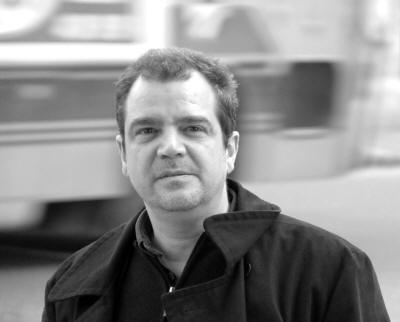|
Daniel
Escardó was born in Montevideo (Uruguay) in 1957. His
great-grandfather was an engineer; his grandfather was a
well-known doctor; his father was a radiologist, a
professor of anatomy in the School of Fine Arts, and had
hobbies such as archaeology and art. His mother was
interested in literature and writing poetry.
Escardó spent his adolescence in his father’s clinic,
surrounded by archaeological specimens, human bones, the
dark room and the laboratory. The cellars of the clinic
were full of old physical-therapy aids from the 1930s.
The libraries contained of material on anatomy and art.

During
the seventies, Escardó completes his baccalaureate in
engineering, and discovers he has a passion for the
geometry of space. He later expands this knowledge by
becoming skilled in the use of software for managing 3D
models. His interest in photography and video then lead
him to record all kinds of living forms and study
biological geometries.
All these
roots and fads begin to bear fruit and coalesce in a
very personal form of art. In 1975 he begins to produce
his first drawings and paintings. His initial works are
huge acrylics on canvas, in which he uses new techniques
that he himself develops in research workshops. During
the ‘80s he switched to airbrush and sweeping turbine
techniques with acrylic paints diluted in great amounts
of water, so that it ran on the canvas impelled by the
turbines. At that stage he also works resorting to the
weather, rain and wind have a role to play in his work.
He receives the “1986 Inca Painting Award” and the
“Elizabeth Rosenfeld Award” at the Gramado Biennial in
Brazil.
Between the years 1983 and
1985 he participates in the workshop of Guillermo
Fernandez (one of the youngest disciples of Torres
García). In the Fernández workshop Escardó begins to use
the logical-geometrical system that the master had
developed as a teaching method. With him he also
analyses Rembrandt´s drawings, taking photos of small
portions with macro lenses, generating enormous
enlargements, and revealing a system of constructive
symbols with which Rembrandt made up his images.
In the 90s Escardó improves
his painting technique and discards complexities and
finally returns to the simplicity of brush and ink on
canvas, showing a preference for drawing at high speed.
This is when “Dibujos Ambidextros” (Ambidextrous
Drawings) appear, a series of geometrical drawings using
both hands.
In 1990 he starts to develop
his first notions of dynamic sculpting. This sculpting
technique is based on patterns that are repeated until
the general structure of the piece is reached. The
geometry and forms governing all living organisms have
since become a focal point in all his work.
In 1991
he wins the “Alcan Grand Award” in sculpture with his
“Dodecahedron”. This work sets the starting point of a
special constructive system: for the first time Escardó
brings into play a system which recalls the children’s
toy “Meccano”. The results drive him to research further
into this sculpting technique. After spending all of
1992 in North America, he returns to Montevideo, where
he begins to perfect the concept of dynamic sculpture by
executing large pieces included in the “El Zoo
Mecanimental” (Mechanical-Mental Zoo) and “Save The
Humans” installations. During this stage, Escardó adds
neon and argon gas to his work, inserting this linear
inner light within metal structures.
In 1996 he plunges into
researching in the use of 3D management software. This
allows him to polish his geometric concepts, and he
manages to apply the new techniques to two different
activities: sculpture and engraving. The “Naturaleza
Digital” (Digital Nature) series of engravings was
conceived in 3-D Max, a software that generates virtual
objects and which helps him develop his own geometry,
which he then wraps in a “skin” provided by the images
of his painting and sculpting. This computer-based
handling of a virtual reality blended with his return to
working with matter itself produces a feedback; and his
geometrical world starts to interact and becomes
increasingly richer.
In early 2000, Escardó comes
up with yet another system of sculpting in cast
aluminum, while maintaining the concept that these
elements are generic and consequently their function may
change: a head can be a base, and vice versa. With this
new technique Escardó creates a series of pieces, the
elements of which are interconnected in such a way that
once the sculpture is constructed, all the parts can be
moved to modify both expression and attitude.
This new approach results in
the “Especies en Vías de Aparición” series (an
untranslatable play of words which means the opposite of
endangered species), in which most of his previously
acquired knowledge is integrated: ranging from
traditional cast metal to state-of-the-art computer
technology. The originals are not static but modifiable,
thus allowing for successive changes to be introduced in
the new creations: the sculptures evolve and behave as a
true biological species.
Nowadays his research leads
him to develop great structures, using the acquired
knowledge, synthesizing shapes. In some way this draws
him towards the geometrical, but never entirely
discarding his biological beginnings.
Latest Exhibitions
2007- Galeria de las
Misiones José Ignacio 2004- “Objectum” Montevideo World
Trade Center 2003-Objects from the “Salisis” series -
OAS Washington DC 2002-“Juguetes de Culto” (Toys of
Cult) – Kreuzberg Hall, Berlin 2003-Uruguay Cultural
Foundation for the Arts – Washington DC 2002-Permanent
Collection – Latin Collector Gallery – New York
2002-“Nautas” – permanent collection – Montevideo World
Trade Center -2001 South-Art, Miami -2001 “Especies en
vías de aparición” (Emerging Species) – Latin Art
Gallery, Miami 1999 “Un Mundo Solvente” (A Reliable
World) – Installation – American Art Museum – Maldonado,
Uruguay |